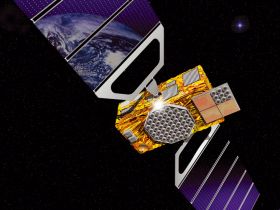 The NLR has developed a tool that will be able to statistically reveal the reliability of satellite navigation. In December 2012, this tool, called GIMAT (GNSS Integrity Monitoring and Analysis Tool), will be deployed at the Eelde airport to check the integrity of the combined GPS and EGNOS systems.
The NLR has developed a tool that will be able to statistically reveal the reliability of satellite navigation. In December 2012, this tool, called GIMAT (GNSS Integrity Monitoring and Analysis Tool), will be deployed at the Eelde airport to check the integrity of the combined GPS and EGNOS systems.
The European Geostationary Navigation Overlay System (EGNOS) has 35 receiver stations that monitor the quality of the GPS signal above Europe. EGNOS permanently informs GPS users of the observed status of the system via three geostationary satellites. In this way, EGNOS significantly enhances the accuracy and, more importantly, the reliability of GPS. But who tests the quality of EGNOS?
For this, NLR, in collaboration with partners Delft University of Technology, S&T, and Integricom, and commissioned by the Netherlands Space Office, has developed and validated ‘GIMAT’. GIMAT is innovative in that it is the first tool that allows quantitative judgments about the integrity of GPS with regard to the demands of the aviation authority ICAO. When an aircraft wants to land safely using satellite navigation, the navigation system cannot provide misleading information – with all the consequences that this would entail. Statistically, in order to comply with the ICAO demands, the EGNOS system may only make a mistake once every 23 years.
The aviation sector currently mainly uses navigation beacons, such as the Instrument Landing System at airports. This is a relatively expensive system that requires substantial maintenance and inspection, but it is extremely reliable. The worldwide aviation sector is preparing for the arrival of flights based on satellite navigation. The advantages of this are that it is cost effective while also being one large system applicable worldwide, and hence identical everywhere.
To see if GPS, combined with EGNOS, meet the requirements, a GPS and EGNOS receiver will be placed at Eelde airport in December 2012. This will be done in preparation for the development and implementation of an EGNOS-based approach procedure for aircrafts. This receiver will collect data during a three-month period. The data will then serve as input for GIMAT, and GIMAT will provide a statistical analysis. This will reveal whether EGNOS meets the ICAO requirements in the area surrounding Eelde airport. This will be the first time that extremely fundamental statistics reveal the reliability of satellite navigation.
Also visit our Satellite Navigation capability page.

